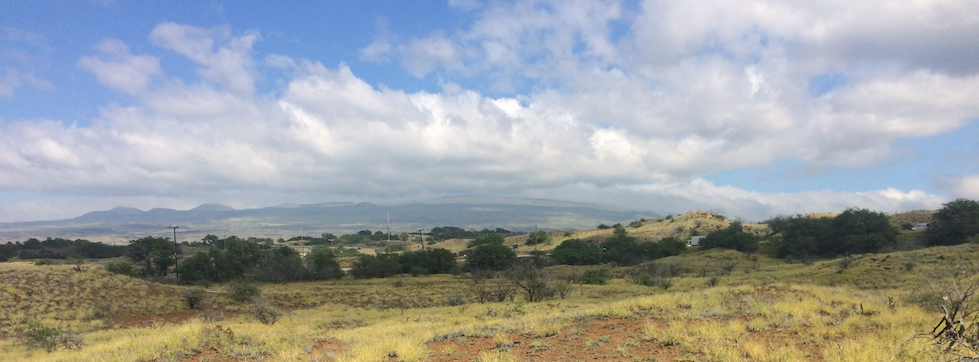TREX 2017: Sharing the Results and Saying Aloha to Hawaii

[fusion_text]Preparing to Communicate with the Public | January 24, 2017 | Daniel Richman
For scientists, conducting research is only half the job. We also need to communicate our findings to our sponsors and to the public. Otherwise, who will know what we’ve been up to?
TREX spent Tuesday preparing our presentation for the Kona Science Cafe, a monthly event where interested citizens hear from scientists working in Hawaii. We will discuss progress in our air monitoring and precision agriculture research projects and answer questions about our work and future plans. Personally, I expect an interested and enthusiastic crowd and am eager to talk to people about their island.

TREX makes slides in our A-frame at Hapuna Beach. From left, Prof. Kocar, Billy, Alexa, Danielle, David (TA), Jon (TA).
Besides making slides, I’ve been analyzing the data we collected when we flew a sulfur dioxide sensor into the air with our drone. We measured SO2 concentration above the Ka‘u Coffee Mill (pronounced Kah-oo) at altitudes from 15 meters to 130 meters. On windy mornings, Ka‘u lies straight in the vog path from Kīlauea volcano to the coast at Pahala, and we recorded high SO2 concentrations near ground level. We’re still analyzing that data and will be presenting on it also. Our time in Hawaii is coming to an end, but the science will continue!

The desert view from Hapuna Beach. The mountains in the distance include Kohala.
Presenting Research to the Community | January 25, 2017 | Tchelet Segev
The long awaited day has finally arrived: today we present our work to the public in a science talk. Bright and early we were grinding away editing the slides, practicing speaking, visualizing our data, and fielding questions we made up for ourselves. All with lovely smiles, even at 9am.

Preparing for the presentation
[/fusion_text][one_half last=”no” spacing=”yes” center_content=”no” hide_on_mobile=”no” background_color=”” background_image=”https://cee.mit.edu/wp-content/uploads/2017/01/pic-2.jpg” background_repeat=”no-repeat” background_position=”left top” hover_type=”none” link=”” border_position=”all” border_size=”0px” border_color=”” border_style=”solid” padding=”” margin_top=”” margin_bottom=”” animation_type=”0″ animation_direction=”down” animation_speed=”0.1″ animation_offset=”” class=”” id=””][/one_half][one_half last=”yes” spacing=”yes” center_content=”no” hide_on_mobile=”no” background_color=”” background_image=”https://cee.mit.edu/wp-content/uploads/2017/01/pic-3.jpg” background_repeat=”no-repeat” background_position=”left top” hover_type=”none” link=”” border_position=”all” border_size=”0px” border_color=”” border_style=”solid” padding=”” margin_top=”” margin_bottom=”” animation_type=”0″ animation_direction=”down” animation_speed=”0.1″ animation_offset=”” class=”” id=””][/one_half][one_full last=”yes” spacing=”yes” center_content=”no” hide_on_mobile=”no” background_color=”” background_image=”” background_repeat=”no-repeat” background_position=”left top” hover_type=”none” link=”” border_position=”all” border_size=”0px” border_color=”” border_style=”” padding=”” margin_top=”” margin_bottom=”” animation_type=”” animation_direction=”” animation_speed=”0.1″ animation_offset=”” class=”” id=””][fusion_text]
Underneath the presentation venue, where ocean water is pumped up to cool the building.
The presentation was attended by a wide variety of community members, ranging from David whose ranch we visited, to teachers at the school across the road where we had installed a sensor to water chemists to children.

Presenting the results of our TREX research
We had some exciting findings to share with them. We found that there likely is a variation of SO2 concentration at different altitudes, which we measured when we flew our drone vertically and took measurements every 10 m, but we need to take more measurements to determine the trend.
In the one sweet potato field we analyzed, there did not appear to be a correlation between pH or sulfate and NDVI levels (a measure of plant health). This field’s levels were within the healthy range, so we would not expect them to be the limiting factor for plant health. However, we are super excited to go back to MIT and analyze other nutrients (potassium, nitrates, and phosphates) both in this field and another field where we collected samples.
We were also able to calibrate our sensors from the millivolt unit to parts-per-billion (or concentration), so that our data matches with the data from the Department of Health. Now we are going to leave our sensors here and see how they do over time, so stay tuned for next year’s TREX!
To celebrate after our presentations, we went out and got two 28 inch pizzas. And no, we were not able to finish all of it.

Celebrating with pizza after the presentation.
Aloha Hawaii
Aloha, we have learned, has a multitude of meanings. Not just hello, but also good bye, and many more meanings that I simply think are lost in translation, that even after two weeks in Hawaii I likely still cannot even begin to comprehend.
TREX was an adventure with many misadventures. An experience never to be forgotten for the friendships forged, the culture seen, and the science learned. It was physically challenging, from sleeping on wooden planks to swimming against currents, but it was far more mentally challenging, from problem solving on the fly in the field to doing science dawn to dusk. What do we do when there are no calibration solutions? How do we stitch together images when the default software does not work? How do we create a model converting to the correct unit of measurement?
I still don’t know the answers to all of those questions, but as a team, we do. Together, we bulldozed through problem after problem, learning along the way not only how to do field work from soil analysis to calibration to flying drones to sensing, and not only how to work together in large groups, but the importance of collaboration and communication in engineering.
Who knew I would fall in love all over again with a field I didn’t even know existed before coming to MIT. I’m excited to continue learning in Boston, not just about the science and engineering, but how we can use it to transform the world. Mind, hand, and heart: that is TREX.
Every year, a group of MIT students and professors travel to the Big Island of Hawaii to gain fieldwork experience through TREX (Traveling Research Environmental EXperiences). The first TREX trip was held in 2000, and since launching has taken students on research activities in domestic and international settings. For more undergraduate opportunities, click here.
[/fusion_text][/one_full]
Share on Bluesky


